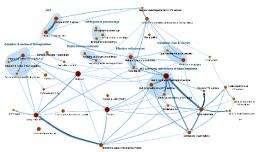Physicist Atieh Mirshahvalad uses network models to better understand the connection between the flow of information and social structures. Among other things she has introduced a group formation model for social systems. Atieh Mirshahvalad defends her thesis on Friday September 20 at Umeå University.
"When we propose a network model, we need to take information and communication into account. In this regard, I propose a group formation model for social systems. This model shows that social groups are formed as a result of feedback between social ties, e.g. friendship, and individuals' intrinsic interest," says Atieh Mirshahvalad.
Complex networks provide a powerful way of modeling and analyzing complex systems based on interacting elements. The interaction pattern links the elements of the system together and provides a structure that controls how information permeates throughout the system.
Once we have good models for group formation, we also need good tools for identifying groups (communities) in real networks. However, network communities are reliable only if they are statistically significant.
Atieh Mirshahvalad discusses a new method for assessing the significance of communities for sparse networks that are inherently sensitive.
"I show the result of our method on the sparse network of the European Court of Justice (ECJ) case law, for example, to detect significant areas of law. We used our significance analysis to draw a map of the ECJ case law network that reveals the relationships between different areas of law. "
Finally, Atieh Mirshahvalad have focused on the simple spreading models that researchers often use to understand how information flows through a network. Often, these spreading models assume that different kinds of information are equally likely to spread through the network, disregarding the intrinsic characteristics of the information. These assumptions are an oversimplification: no idea is independent from other ideas and waves of new information or technology necessarily interact with one another as they propagate through society.
To account for such interactions, she has used a simple model in which different information waves interact with each other based on their novelty and analyzed the global effects of such interactions.
"I found that information that actually reaches nodes reaches them faster. "
Atieh Mirshahvalad is originally from Iran and she took a master degree in the Amirkabir University of Technology (Tehran Polytechnic) in Teheran.
More information: About the public defense: On Friday, September 20, Atieh Mirshahvalad, Department of Physics, Umeå University, will publicly defend her dissertation titled: "Organization of information pathways in complex networks". urn.kb.se/resolve?urn=urn:nbn:se:umu:diva-79734
Provided by Umea University



















